Where we want to go
Where we want to go
Strategic components from genetic diversity to sustainable cocoa production
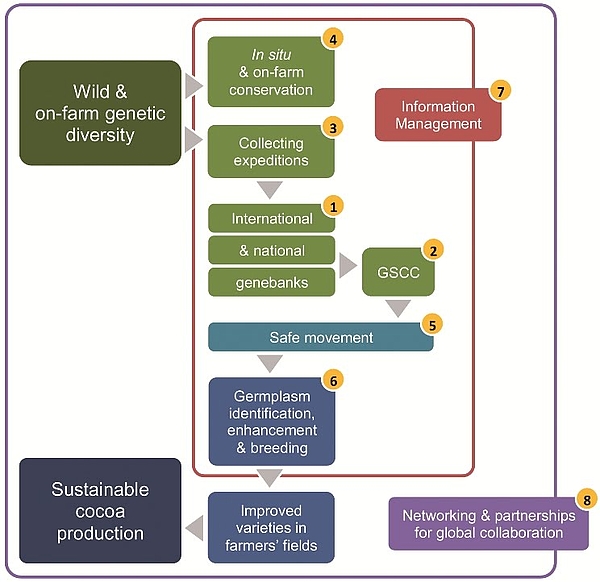
- Securing existing ex situ cacao genetic resources and their distribution
- Developing a Global Strategic Cacao Collection (GSCC)
- Genetic diversity gap filling in ex situ collections and collecting
- Ensuring the in situ and on-farm conservation of important genetic diversity
- Strengthening the distribution mechanism and safe movement of germplasm
- Strengthening the use of the cacao genetic resources by providing support to breeders and key users through improved characterization, evaluation within collections and supporting population enhancement programmes
- Improving documentation and sharing of information on germplasm
- Strengthening the networking and partnerships for global collaboration
Securing existing ex situ cacao genetic resources
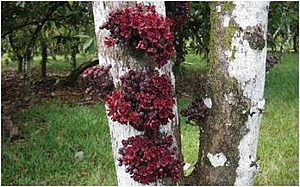
The immediate priority of the Global Strategy is to secure the conservation and accessibility of genetic diversity currently in ex situ collections to all users, particularly those held in the public domain. This diversity is critical to ensure the future of the world cocoa production to generate improved planting materials to face new challenges of pests and diseases, climate change, agronomic conditions, and changing consumer preferences.
The Global Strategy provides a clear framework for public and private sector investment. The current funding of cacao conservation and use activities is born by the many national research institutes with the help of industry and international organisations and is below optimal levels. Many national collections are struggling to keep their material alive. Even the funding to the two international collections at CATIE and CRU/UWI and the ICQC,R is only a 3-year planning basis, is not guaranteed and therefore their sustainability is not secured over the long-term.
The Global Strategy calls for the development of an endowment fund (or similar sustainable funding mechanism) dedicated to the conservation and use of cacao genetic resources. Such a fund would secure valuable genetic resources in the public domain, forever, by: (1) securing its conservation and availability (including safety-duplication), (2) promoting participation of all partners through support for collecting to fill gaps, characterisation and evaluation, documentation systems, and promoting access to and use of materials and (3) increasing efficiency and effectiveness to reduce costs and increase sustainability.
Developing a global strategic cacao collection
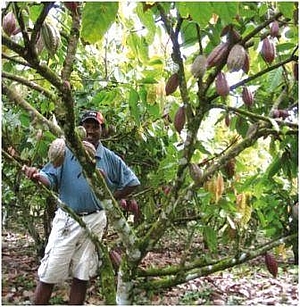
The Global Strategy calls for a Global Strategic Cacao Collection (GSCC) to be established as a virtual collection of materials that have been identified as unique and interesting, which each of the participating institutes agrees to maintain in the public domain and make readily available to any bona fide user. The formation of the GSCC will require a coordinated effort to characterize and rationalize available cacao genetic resources.
The development of the GSCC will be based on a thorough assessment of the cacao genetic diversity currently conserved in ex situ collections and the identification of those unique accessions for use by breeders and researchers, available in the international and national collections. It will be a dynamic and geographically dispersed collection composed mainly of wild accessions and landraces. The backbone will consist of accessions from the international collections managed by CATIE and CRU/UWI collections, for which considerable characterization and evaluation data are already available in the public domain, complemented with priority accessions from national collections.
The GSCC has agreed criteria that will be used to identify priority accessions. A first set of accessions will be selected on the basis of capturing the greatest possible genetic diversity (in the form of allelic richness) held in ex situ collections worldwide. A further set of accessions will be selected on the basis of key traits of interest to breeders and farmers, such as yield, flavour characteristics and disease resistance. The allelic richness component of the GSCC will be relatively static, with new accessions introduced as they are made available from national collections or if unique material is found during collecting missions. The trait component of the GSCC, however, will be more dynamic and subject to a process of rationalization, where existing accessions may give way to new material that expresses a given trait more highly or has a better combination of traits.
Global system for the conservation and utilization of cacao genetic resources
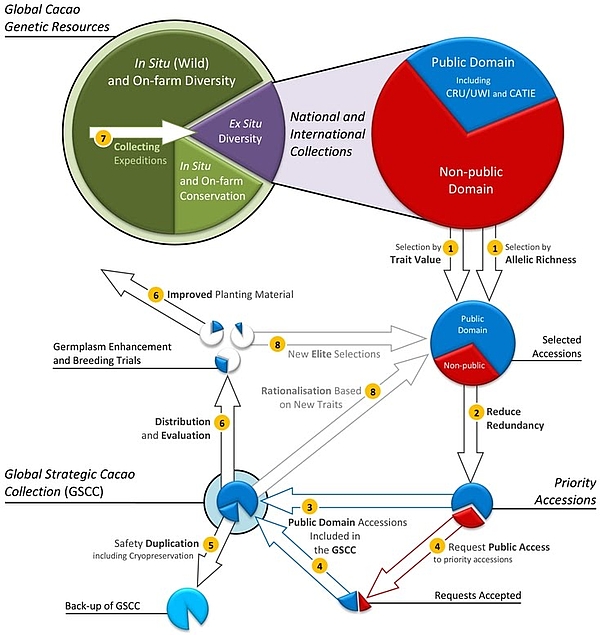
Partners will agree on how to share responsibilities for conserving and distributing material from the GSCC, and long-term funding will be discussed with the Global Crop Diversity Trust, other international donors and with the private sector. CacaoNet will continue to facilitate the dialogue between the ITPGRFA and the countries that are maintaining cacao materials targeted by the GSCC, in order to encourage countries to follow the example of CATIE and CRU/UWI and place selected accessions under the Treaty. CacaoNet will also ensure the continuing development of the GSCC in consultation with all its members.
Diversity gap filling in ex situ collections and collecting
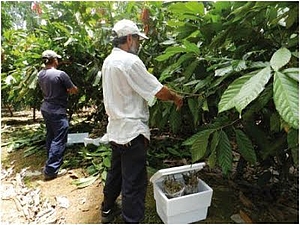
Analysing the status of the cacao genepool in its centre of diversity (Upper Amazon and Mesoamerica) is a priority for the Global Strategy in order to promote the development of early warning systems for endangered diversity and to understand the threats of genetic erosion.
Geographic Information Systems (GIS) will be used to map the spatial distribution of different cacao populations, using additional information about genetic diversity in wild cacao populations to guide future collecting missions. In addition, collecting will be directed to places where one might reasonably expect to find a higher frequency of desirable traits, such as disease resistance. The main priority for collecting will be to fill gaps in ex situ collections, with a focus on threatened wild relatives of cacao and landraces, to facilitate use.
The research will be carried out by a network of experts with complementary skills in taxonomy, diversity analysis and conservation of genetic resources, especially in situconservation. CacaoNet will play a role in ensuring the participation of key stakeholders and to build capacity in diversity analysis in the partners responsible for conservation of cacao in its centre of diversity.
Ensuring the in situ and on-farm conservation of important diversity
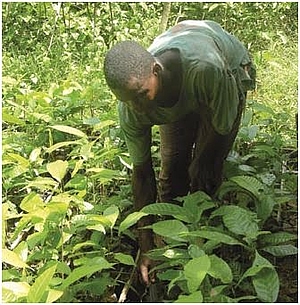
In situ and on-farm conservation is influenced by complex social, political and biological factors. Habitats suitable for wild Theobroma species are increasingly degraded and fragmented and the drivers and consequences of these changes are currently not well understood. On-farm conservation depends ultimately on farmers as the final decision makers, choosing particular varieties they wish to use and conserve. The traditional cacao varieties that many farmers prefer often have lower yields, but recently some of these have acquired a reputation for high quality and are increasingly coveted by specialty gourmet markets. Some of these landraces can also be important sources of pest and disease resistance valuable to breeders. It is therefore critical to understand the social and economic factors that influence farmers’ decisions to maintain cacao diversity, and to assess the implications of these factors for the design of in situand on-farm conservation strategies.
The Global Strategy calls for a greater effort to understand and conserve the diversity of cacao and its wild relatives, using a variety of initiatives such as national forest reserves, wildlife refuges, and private reserves, all of which can help preserve natural plant communities. Partnerships with governmental agencies with responsibility for forestry and environmental issues and local-level authorities in target countries, plus national and international conservation NGOs, forestry research institutes, farmer communities and civil society organizations, as well as the private sector, will be needed for successful in situ and on-farm conservation.
Strengthening the distribution and safe movement of germplasm
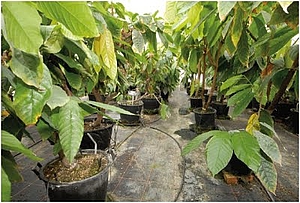
Risks associated with pests and diseases need to be minimised before cacao diversity can be freely accessible and used by different research institutes around the world. The safe movement of cacao germplasm will be promoted through the updated 2011 safe movement guidelines, available to download on the CacaoNet website here, can also be disseminated as printed copies to relevant institutes and to plant health authorities. The guidelines will be translated into French and Spanish and will be updated as new information becomes available.
CacaoNet will work with the International Plant Protection Convention (IPPC) and its regional organizations to ensure that the updated guidelines are widely available to those responsible for the phytosanitary systems in cocoa-producing countries. Part of this will involve developing effective ways to raise awareness of the importance of safe movement of germplasm to the cacao community, working closely with groupings such as INGENIC and COPAL.
The Global Strategy will strengthen the current system of germplasm distribution through the ICQC,R and support the development of new quarantine centres in each of the three regions (Americas, Africa and Asia) to facilitate the safe movement of germplasm within regions.
Strengthening the use of cacao genetic resources
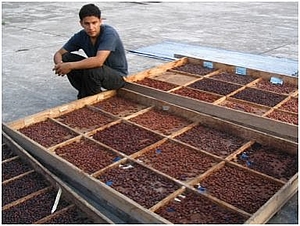
he use of accessions in the GSCC should start with their further evaluation for economically important traits. Accessions that possess the required traits can then be sent to quarantine before distribution to requesting countries. The Global Strategy will collaborate closely with INGENIC’s regional breeding networks and other partners to develop a network of field trials that will evaluate GSCC materials at multiple sites. The network of evaluation sites will develop reliable and standardized methods and share evaluation information publically through CANGIS.
To facilitate the selection of new accessions to be introduced by user countries, a list of the main traits of accessions held in the ICQC,R will be compiled, which will help breeders identify materials of potential interest that are currently available for international distribution. Moreover, information in the GSCC Information Portal will assist them in prioritizing material from local and international genebanks for inclusion in their breeding trials following appropriate quarantine procedures. This work will be done in collaboration with INGENIC and the regional breeding networks where CacaoNet will play a coordination role.
The identification of the most useful GSCC germplasm for distribution, adapting to the evolving needs of breeding programmes, will continue. Germplasm of current interest includes the material from the CFC/ICCO/Bioversity project, materials from the black pod and witches’ broom enhancement programmes in CRU/UWI and genotypes with frosty pod resistance identified in CATIE.
Improving documentation and sharing of information
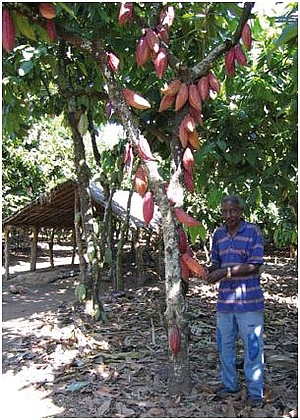
A simple yet robust information management system, that combines comprehensive and accurate information on the origins, conservation locations, availability and characteristics of individual accessions, will be the portal to accessing all relevant information and be a key component in the establishment, management and use of the Global Strategic Cacao Collection (GSCC).
As part of the GSCC information portal, a central database, CANGIS (CacaoNet Germplasm Information System), will bring together all the genebanks and other service providers that collectively form the GSCC and facilitate their effective management. CANGIS will maintain specific, high quality data (including passport descriptors and the characters supporting an accession’s inclusion in the GSCC) on all the individual accessions (trees located at specific sites) that make up the GSCC, and provide a means for users to access this germplasm. CANGIS will coordinate the compilation of characterization and evaluation data from all collections, supported by the molecular verification of the accessions to which the data pertain. CANGIS will link to existing international databases, such as ICGD and TropGENE, in order to access additional information that is of interest to potential users of the germplasm.
Mechanisms will be developed to link the GSCC to information and local knowledge on in situ and on-farm genetic resources. These databases will be linked over time to multicrop global information systems, such as GENESYS, as they are developed.
The development of CANGIS will be coordinated by CacaoNet and work closely with national programmes, and collections that do not have a local information management system already in place will be encouraged to adopt GRIN-Global (a freely available genebank management tool and information system developed by the USDA and partners).
Components of the GSCC Information Portal
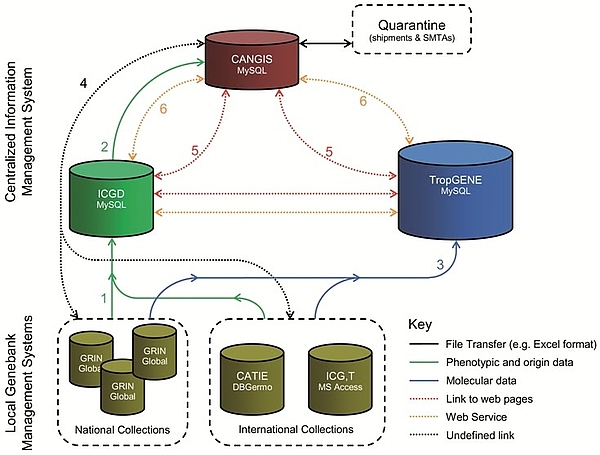
1: Characterisation and evaluation data are sent to ICGD (includes non-CacaoNet accessions and information).
2: Once checked and standardized, information on the Global Strategic Cacao Collection accessions is entered into CANGIS.
3: Molecular data are sent to TropGENE (includes non-CacaoNet accessions and information).
4: A degree of direct networking between Global Strategic Cacao Collection IMS and the local genebank management systems is required for monitoring/tracking accessions in the base and active collections. The form this will take will largely depend on the genebank management systems that are adopted (e.g. GRIN-Global).
5: In order to access additional information available from one of the other databases, the user can be linked directly to the relevant page on the collaborating website (all of the databases use the same variety identification codes).
6: Web services allow an information management system to query distributed databases and integrate the results with its own output, removing the need to physically transfer the user to the other database.
Strengthening partnerships for global collaboration
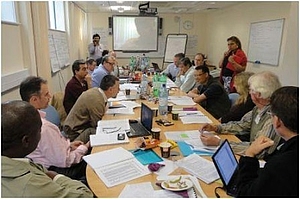
All countries with an interest in cacao, i.e. producers, processors and, of course, consumers, will have to collaborate if the goal of the Global Strategy is to be realized.
National cocoa research institutes and their governments will play a key role in ensuring access to a wide range of diverse genetic resources and related information, facilitating the rationalization of collections and building trust among partners. There will have to be dialogue with decision-making political and administrative bodies in each country, not least to facilitate implementation of agreed regulations for cacao quarantine. Capacity building will need to provide training and equipment support to the collections in the GSCC, with particular reference to genebank management, germplasm evaluation, information management and data analysis, and policy and legal aspects of germplasm exchange.
CacaoNet will play an important part in these efforts. It will ensure agreement on the establishment of the GSCC and oversee its development on behalf of all its members, and will actively engage in fund-raising for the implementation of the Global Strategy. CacaoNet will also encourage collaboration with national collections, FAO and the ITPGRFA to help ensure that germplasm, particularly accessions identified for inclusion in the GSCC, is placed in the public domain.
Global Strategy
- Abstract
- Preface
- What needs to be done?
- Where we are today
- Where we want to go
- How can you help?
- Partners and acknowledgements
- References
DOWNLOAD
The entire Global Strategy document can be downloaded here: Cacaonet Global Strategy - Full document (PDF 2.4Mb)
A brochure of the Global Strategy can be downloaded here: CacaoNet Global Strategy - Brochure (PDF 2.5Mb)